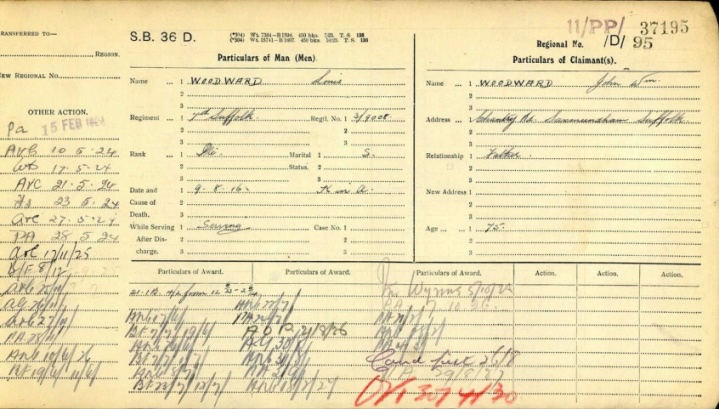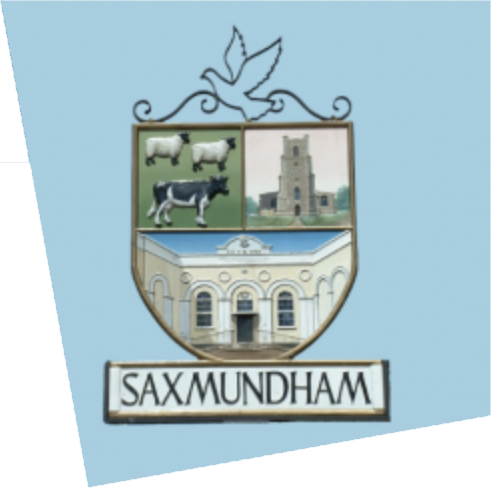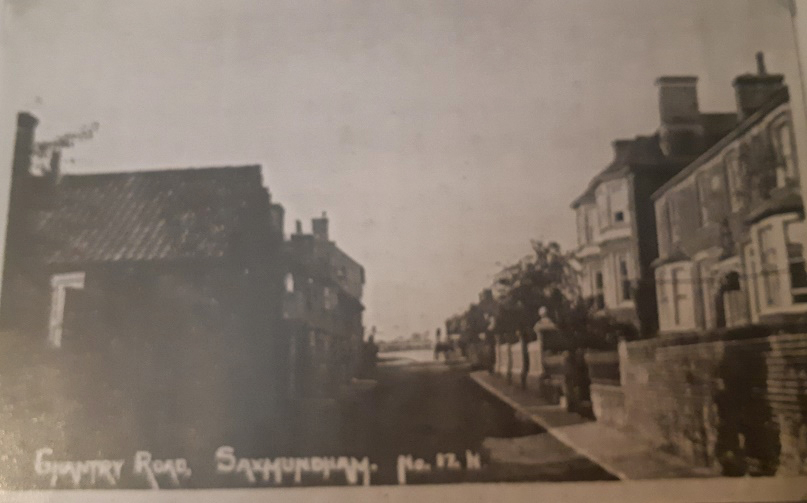
Photo courtesy of Saxmundham Museum
Chantry Road, stop 17 (a)
CSM 3/9988 Henry Edward Backhouse, MM 8th Battalion, Suffolk Regiment, 1892 – 12 October 1917
Most likely Henry Edward was a Territorial Army soldier before enlisting in Lowestoft as a sergeant in the 8th Battalion of the Suffolk Regiment. Posted to France on 25 July 1915, Henry returned home on leave and married Alice Maud Cleveland from the Lowestoft area in July 1917. Mentioned in despatches and awarded the Military Medal Henry Edward lost his life in Poelcappelle in Flanders on 12 October 1917, just four months after his marriage. The area was horrendous with huge craters filled with water so deep that a man could drown; the valleys of the streams were impassable. ‘Major Fache and C.S.M. H.E Backhouse and a runner tried to gain touch with the 6th Royal Berkshire Regiment, ….. Backhouse being shot dead’.
Henry Edward Backhouse, the son of Saxmundham man, Ebenezer and his wife Sarah from Kent was born in 1892, probably in the Bayswater district of London. Ebeneezer’s stay in London was short lived as the family returned to Saxmundham by 1901 when the family lived in Chantry Road. At that time, his father was a self-employed Whitesmith or tinsmith, (a metalworker). Ebenezer’s change of career a decade later highlights the general improvements in living conditions. Now a hot water fitter he still provided a home for five of his eight living children. Henry Edward, now 19 was the eldest of them.
In 1911 Henry Edward, worked as a bottler of mineral water, possibly working for Henry Lawrence and Sons who owned plants in Beccles, Saxmundham and Great Yarmouth. Furthermore, as Henry Edward’s rank on enlistment was as a sergeant it is most likely that he was a Territorial Army soldier. Henry enlisted in Lowestoft and was posted to France, 25 July 1915.
Whilst many of his comrades fell Henry survived the horrors of the Battle of the Somme, (the offensive largely ran from 1 July to 18 November 1916), albeit Henry was still stationed on the Somme in the aftermath. Henry was promoted to Acting Company Sergeant Major before February 1917. For his actions in the Battle of Boom Ravine, 15 – 18 February 1917 he was mentioned in despatches, the Commanding Officer wrote:
‘I cannot speak too highly of the action of all ranks of this Company, they met strong opposition, uncut wire and many snipers etc. over which the barrage had passed. The conduct of the N.C.O.’s and Lewis Gunners appears to have excellent throughout and it is hard to single any out in particular. The services of the following member of the Company were particularly conspicuous’ including 3/3998 Sgt. A/C.S.M. Backhouse. H.E. Henry as Company Sergeant Major would have been the senior non-commissioned officer in ‘B’ Section when:
‘The enemy were now firing a considerable number of Trench Mortars from Boom Ravine chiefly directed against our Lewis Guns but these did little damage. The only method was now to get round the flanks of the Strong Points. Two parties now got a footing in the trench. Cpl. Wade was held up at once by enemy rifle grenades but did most valuable work while Sgts. Backhouse and Wiggett were working round the flanks…. The enemy now seeing parties gradually getting round their flanks and with parties already in the trench surrendered.’
Basically, due to Backhouse and Wiggett’s action this part of the battle was won. And indeed, it helped to force the enemy back to the Hindenburg Line. Likely the Military Medal Henry received (as reported in the Gazette 19 April 1917) was for this act of bravery.
Henry returned home on leave and married Alice Maud Cleveland from the Lowestoft area in July 1917. Tragically the marriage lasted at the most four months.
Henry Edward lost his life at Poelcappelle in Flanders on 12 October 1917. The area was horrendous. Huge craters filled with water so deep that a man could drown. Thick mud. ‘Pock marked with shell holes, often so full of water that men had to struggle to prevent themselves from drowning. The 8th battalion encountered considerable enemy barrage between Rose Trench and the Langemarck road. The valleys of the streams were impassable. ‘Major Fache and C.S.M. H.E Backhouse and a runner tried to cross the road through the village to gain touch with the 6th Royal Berkshire Regiment, Backhouse being shot dead’. After that, the advance was abandoned. Henry Edward was one of 232 casualties on that day. He sadly has no identifiable grave and is commemorated on the Tyne Cott memorial. Henry is also remembered in Saxmundham, where his mother and siblings contributed to the Memorial Fund. Moreover, he is also on Lowestoft’s Town Memorial, in St Margaret’s Church and St John’s Church. His widow wanted to remember him in her hometown, the place that he enlisted just over two years before his death. It is perhaps a testament to his bravery that his name is recorded at least five times and it is important that his story is told.
Chantry Road, stop 17 (b).
Lance Corporal, 9592, Herbert George Peaty, King’s Own (Royal Lancashire Regiment), 2nd Battalion, 1894-20 February 1915.
Herbert George Peaty the son of Herbert Frederick and Ada Peaty was born in Queensferry, Linlithgow, Scotland in 1893. One initially wonders why he is commemorated on the Saxmundham War Memorial but by following his father’s, Herbert Frederick’s military career the answer is easily established. Herbert Frederick was a career soldier, who served in the marines, army and again in the marines during World War One. The family moved to Suffolk by 1907, first to Yoxford then Chantry Road. Herbert George enlisted in Ipswich and joined the 2nd Battalion of the King’s Own (Royal Lancaster Regiment) as a drummer.
Herbert Frederick was a career soldier, firstly in the Marines, then Army and again in the Marines after declaration of War in 1914. Aged seventeen he enlisted in the Marines in August 1875 as a private. Promotion soon arrived and by May 1881 Hebert Frederick was a corporal. He waited another thirteen years to achieve his status as sergeant in 1894. Just two years earlier, whilst serving on the vessel Caledonia, a training ship, he married Ada Fanny Pain from Deal, Kent on 15 October 1892 in Queensferry. Their first of seven children, Herbert George, was born nine months later, on 23 July 1893, in sight of the newly opened Forth Rail Bridge at Craigview, Queensberry.
Thereafter the family moved to Kent. Whilst based at Walmer, near Deal, Herbert Senior and Ada had at least four more children, Dorothy, Nellie, Reginald, and Ada all born between 1896 and 1902. By 1907 the family relocated to Suffolk and their seventh child Jack arrived. Herbert Senior left the marines and joined the army in the Suffolk Regiment in 1904 until 1908. During the temporary break from military life, the family less Herbert junior lived in Yoxford High Street, where Herbert senior was a School Attendance Officer.
It is likely that Herbert junior’s decision to join the army aged seventeen was influenced by his military upbringing. Throughout his informative years he witnessed his father serving his country. Herbert junior enlisted in Ipswich and joined the army in the 2nd Battalion of the King’s Own, (Royal Lancaster Regiment) as a drummer. One of his first postings was to Fort Regent, Jersey in the Channel Islands. However, he soon experienced more exotic places.
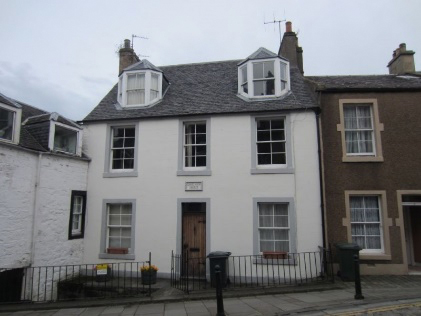
Craigview, Queensferry
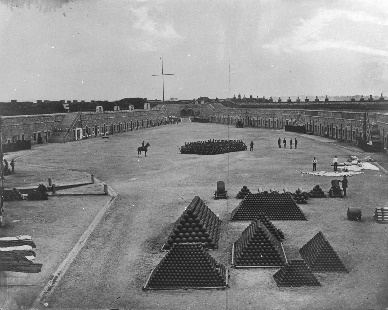
Fort Regent, Jersey.
On declaration of war Herbert Junior’s battalion was based in Lebong, India. Close to Darjeeling in the Eastern Himalayas, Herbert was stationed in beautiful countryside used by the British as their India summer retreat. In stark contrast, he left the subcontinent in November 1914, on the S.S. Kenliworth Castle to fight in Europe.
With his comrades Herbert George arrived at Plymouth on 22 December 1914 then proceeded to Winchester College and joined the 83rd Brigade of the 28th Division. Perhaps he was permitted leave to visit his family that by now had moved to Chantry House in Chantry Road, Saxmundham? Possibly he did not see his father who had re-enlisted in the Royal Naval Division for the duration of the war and was based in the Portsmouth where he was promoted to Warrant Officer. Unlike his son, he remained in the country.
Mobilised for war Herbert junior landed at Le Harve on 16 January 1915. Within just over a month on 20 February 1915, Lance Corporal, Hebert George Peaty died in action in the region of Blauwepoort Farm. Whilst endeavouring to recover a trench captured by the enemy, he was likely one of forty-eight men killed that day. Herbert George has no known grave and is commemorated on the Menin Gate in Ypres and on the Saxmundham War Memorials.
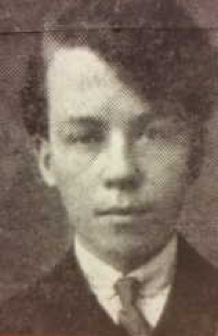
Photo courtesy of Mark Woodard
Chantry Road, stop 17 (c).
Private 3/9008 Louis William Woodard,
7th Battalion Suffolk Regiment (formerly 2nd Battalion), 1891- 9 August 1916
Louis William Woodward enlisted during the first few months of the war in 1914. His prompt enlistment may have resulted from his father’s remarriage to Eliza, a woman some twenty-eight years younger than his father with three children. Moreover, the family size increase with two further children born before 1914. The house in Chantry Road likely was very crowded and Louis was perhaps keen to escape.
Louis, one of seven children of John and Elizabeth was born in Saxmundham where he seemingly lived until he enlisted in Ipswich firstly into the 2nd before transferral to the 7th Battalion. His mother died in 1907 and by 1911 only Louis’s father, John, a bricklayer, his sister Louisa, and Louis, a boot repairer remained at home in Albion Street. The status quo changed dramatically a year later when John married Eliza Poulson, a spinster from Cockfield with three children; May born 1899, Bertie born 1903 and Claude born 1907.
Moreover, the family size increased with the birth of John and Eliza’s child, Marjorie born 1912/13 plus two further children, Alice born 1914, followed by Lewis Jack born in 1919. John at the time of his marriage was sixty-four and worked as a roadman for the Urban District Council. His new wife Eliza was twenty-eight years his junior, the same age as her stepson, Ted, Louis’s eldest brother. By now the family lived in Chantry Road and perhaps keen to escape a household of young half siblings, Louis enlisted to serve his country during the first few months of the war in 1914.
In December 1914 he was posted to France and experienced the horrors of warfare for nearly two years before losing his life fighting in the Pozieres/ Bouzincourt region of France. Louis has no known grave and is commemorated on the Thiepval Memorial. Whilst his father claimed Louis’s Dependant’s Pension for the duration of his life, Louis left his possessions to his sister, Ellen Rice. His father died in 1927 and Louis’s stepmother still lived in Chantry Road in 1939. Ellen in 1939, now married to Harry Rice, a railway porter, lived at Thorpeness Halt, Gate House.
Louis is remembered on Saxmundham Chapel, Church, Fromus Square and Oddfellows memorials.
